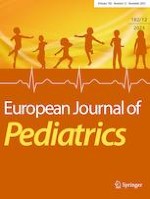Erschienen in:

23.09.2023 | RESEARCH
Comparison among three lung ultrasound scores used to predict the need for surfactant replacement therapy: a retrospective diagnostic accuracy study in a cohort of preterm infants
verfasst von:
Iuri Corsini, Maria Beatrice Lenzi, Martina Ciarcià, Federico Matina, Enrico Petoello, Alice Iride Flore, Silvia Nogara, Antonella Gangemi, Monica Fusco, Letizia Capasso, Francesco Raimondi, Javier Rodriguez-Fanjul, Carlo Dani, Benjamim Ficial
Erschienen in:
European Journal of Pediatrics
|
Ausgabe 12/2023
Einloggen, um Zugang zu erhalten
Abstract
Lung ultrasound (LU) has emerged as the imaging technique of choice for the assessment of neonates with respiratory distress syndrome (RDS) at the bedside. Scoring systems were developed to quantify RDS severity and to predict the need for surfactant administration. There is no data on the comparison of the three main LU scores (LUS) proposed by Brat, Raimondi and Rodriguez-Fanjul. Moreover, there is not enough evidence to recommend which score and which cut-off has the best ability to predict surfactant need. The three LUS were compared in terms of ability to predict the need for surfactant and reproducibility in a cohort of very preterm infants. This was an observational, retrospective, multicenter study. Neonates below 32 weeks of gestational age with RDS, on non-invasive ventilation with a LU performed prior to surfactant administration (1–3 h of life) were included. Brat, Raimondi, and Rodriguez-Fanjul’s scores were calculated for each patient. Receiver-operating characteristic (ROC) curve analysis was used to assess the ability to predict surfactant administration. K-Cohen test, Bland–Altman, and intraclass correlation coefficients were used to assess the intra and interobserver variability. Fifty-four preterm infants were enrolled. Brat, Raimondi, and Rodriguez-Fanjul scores showed a strong ability to predict the need for surfactant: the AUCs were 0.85 (95% CI 0.74–0.96), 0.85 (95% CI 0.75–0.96), and 0.79 (95% CI 0.67–0.92), respectively. No significant differences have been found between the AUCs using the DeLong test. Brat and Raimondi’s scores had an optimal cut-off value > 8, while the Rodriguez-Fanjul’s score > 10. The k-Cohen values of intraobserver agreement for Brat, Raimondi, and Rodriguez-Fanjul’s scores were 0.896 (0.698–1.000), 1.000 (1.000–1.000), and 0.922 (0.767–1.000), respectively. The k-Cohen values of interobserver agreement were 0.896 (0.698–1.000), 0.911 (0.741–1.000), and 0.833 (0.612–1.000), respectively.
Conclusions: The three LUS had an excellent ability to predict the need for surfactant and an optimal intra and interobserver agreement. The differences found between the three scores are minimal with negligible clinical implications. Since the optimal cut-off value differed, the same score should be used consistently within the same center.
What is Known: • Lung ultrasound is a useful bedside imaging tool that should be used in the assessment of neonates with RDS • Scoring systems or lung ultrasound scores allow to quantify the severity of the pulmonary disease and to predict the need for surfactant replacement therapy |
What is New: • The three lung ultrasound scores by Brat, Raimondi and Rodriguez-Fanjul have an excellent ability to predict the need for surfactant replacement therapy, although with different cut-off values • All three lung ultrasound scores had an excellent intra and interobserver reproducibility |











